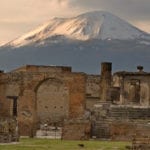 Movies and TV
Movies and TV  Movies and TV
Movies and TV  Health
Health 10 Miraculous Advances Toward Curing Incurable Diseases
 Miscellaneous
Miscellaneous 10 Undeniable Signs That People’s Views of Mushrooms Are Changing
 Animals
Animals 10 Strange Attempts to Smuggle Animals
 Travel
Travel 10 Natural Rock Formations That Will Make You Do a Double Take
 Movies and TV
Movies and TV 10 Actors Hidden in Your Favorite Movies
 Our World
Our World 10 Science Facts That Will Change How You Look at the World
 Pop Culture
Pop Culture 10 Incredible Female Comic Book Artists
 Crime
Crime 10 Terrifying Serial Killers from Centuries Ago
 Technology
Technology 10 Hilariously Over-Engineered Solutions to Simple Problems
 Movies and TV
Movies and TV 10 Movie Adaptions That Brought Popular Songs to Life
 Health
Health 10 Miraculous Advances Toward Curing Incurable Diseases
 Miscellaneous
Miscellaneous 10 Undeniable Signs That People’s Views of Mushrooms Are Changing
Who's Behind Listverse?

Jamie Frater
Head Editor
Jamie founded Listverse due to an insatiable desire to share fascinating, obscure, and bizarre facts. He has been a guest speaker on numerous national radio and television stations and is a five time published author.
More About Us Animals
Animals 10 Strange Attempts to Smuggle Animals
 Travel
Travel 10 Natural Rock Formations That Will Make You Do a Double Take
 Movies and TV
Movies and TV 10 Actors Hidden in Your Favorite Movies
 Our World
Our World 10 Science Facts That Will Change How You Look at the World
 Pop Culture
Pop Culture 10 Incredible Female Comic Book Artists
 Crime
Crime 10 Terrifying Serial Killers from Centuries Ago
 Technology
Technology 10 Hilariously Over-Engineered Solutions to Simple Problems
Top 10 Greatest Archaeological Restorations
The archeological community has conflicting views when it comes to the restoration and protection of valuable archaeological discoveries. Historical artifacts and ancient structures are incredibly delicate; they can never be reconstructed after they have been disturbed and can never be replaced after they have been lost.
Numerous archeological restorations have taken place over the past few decades, often restoring the former glory of a specific site in a spectacular fashion. However, given the infinite harm caused by faulty and ignorant restorations conducted in the last century, archeologists today try their best to conserve new and important sites as they are found—restoring them with minimal interference—giving us a peek into our history and our shared human heritage.
So let’s dig into more details about the restorations of these amazing archaeological discoveries.
Related: 10 Strange Archaeological Discoveries
10 The Pyramid of Djoser, Egypt
Believed to be Egypt’s first stone pyramid, the Pyramid of Djoser was only recently reopened to the public after a meticulous and painstaking restoration that took more than 14 years and $6.6 million to complete. Legends say that the architect Imhotep planned and supervised the construction of the 197-foot (60-meter) structure nearly 4,700 years ago—the very first perpendicular tomb for the Pharaoh Djoser. Although the pyramid seems like a compact mountain of stone from the outside, the inside is actually a vacuous network of walkways over 3 miles (4.8 kilometers) long, assembled with over 11.6 million cubic feet (328,500 cubic meters) of stone and clay.
In fact, it was the complicated interior that inescapably endangered its structural integrity as time went by, while its foundation was almost decimated by the earthquake that hit Cairo in 1992. In order to guarantee structural safety during the restoration, airbags developed by structural engineers were placed across the most vulnerable sections of the pyramid. In addition, steel rods were run through its steps like rebar to help keep its shape. These distinct approaches to its fortification allowed the restoration teams to repair the corridors and ceilings while introducing a new framework for interior lighting. They also added one or two modern updates to make the structure more accessible for people with disabilities.[1]
9 Somnath Temple, India
The 12 Jyotirlingas or Jyotirlingam are the places where Lord Shiva is said to have manifested as a pillar of fire. The Somnath Temple in Gujarat, India, is renowned for hosting one of the twelve. As such, it is a significant tourist and sacred religious site. Throughout history, the temple was reconstructed and restored repeatedly due to its destruction by numerous invaders and their subsequent rule. The present temple was reconstructed again after being pulled down in October 1950 to be relocated to a new site a few miles away.
India’s temples have a long history of devastation and restoration. The restoration of the Somnath Temple was hailed as a leading example of India’s excellence when it came to the power of restoration over the power of devastation. Political leaders saw its restoration as an act that returned the nation’s pride as it took place shortly after India gained its independence from Britain.[2]
8 The Petra Complex, Jordan
The ruins of Petra have been popularized by films such as Indiana Jones and The Last Crusade and Transformers: Revenge of the Fallen. Abandoned in the 6th century, Petra was developed in a seismic zone, making it susceptible to damage from floods and earthquakes. The site was also under considerable threat due to the continuous influx of tourists at the end of the 20th century.
During the 1990s, Petra was included on the World Monuments Fund’s Watch List in an attempt to address its tourism management issues. The WMF, the Jordanian Ministry of Tourism and Antiquities, and the Petra National Trust joined forces and developed a long-term site plan. In addition to other studies, a number of projects led to the restoration of the magnificent Great Temple, several of the columns, the entrance gorge, and the Byzantine Church, as well as the reconstruction of the site’s ancient water canals.[3]
7 Temple of Borobudur, Indonesia
Built from the 8th to the 9th centuries AD, the Borobudur complex was abandoned seemingly overnight in the 1500s. There are three historical sites within the Borobudur Complex: the Borobudur Temple and two smaller temples, built on a horizontal plane to Borobudur to the east. The two small temples are known as the Pawon Temple and the Mendut Temple.
Over the years, the site was covered with ash due to volcanic activity, and Java’s plant life eventually covered the historic ruins. Thomas Stamford Raffles, the then-English governor, began operations to locate and reclaim the site in 1814. It took his team over two months to finally uncover the temples.
In 1972, UNESCO launched an international campaign to restore the illustrious Buddhist temple to its former glory. The restoration work was completed after 11 years in 1983. Historians made use of the site’s existing materials to reconstruct the temple in two stages. Almost all the site’s existing materials were used with only minor additions to strengthen and reinforce the structure and allow adequate water runoff, which did not affect the site’s integrity and value.[4]
6 The Sistine Chapel Frescoes, The Vatican City
The building of the Vatican’s iconic Sistine Chapel, located just north of St. Peter’s Basilica, was authorized by Pope Sixtus IV and finalized around 1481. The chapel is internationally known for the number of invaluable art masterpieces it contains. In fact, several famous artists, among the most illustrious Renaissance artists of all time, including Botticelli and Perugino, contributed significantly to the artworks that can be found on the walls inside the chapel. Pope Julius II asked Michelangelo to beautify the ceiling, keeping the artist busy from 1508 to 1512. The glorious portrait of the Last Judgment by Michelangelo, painted in 1541, was sanctioned by Pope Clement VII.
Michelangelo’s artworks are revered as some of the most remarkable works of Western art ever to be brought into existence. The artworks of the Sistine Chapel and, more specifically, the ceiling and the concomitant apertures by Michelangelo have undergone several restorations over the years, of which the most recent took place between 1980 and 1994.
Its most recent restoration had a significant impact on both art lovers and art historians, as colors and details never seen before were revealed. Many have argued that as a direct consequence, every single book ever written about Michelangelo’s techniques will have to be revised. In short, it means the reevaluation of his style, use of color, and artform as a whole, probably leading to a new vision of the brilliance of the High Renaissance, arguably the single best period in Western art.[5]
5 Karnak Temple Complex, Egypt
The ancient Karnak temple precinct covers an area of more than 247 acres (1 square kilometer) and was located at the eastern bank of the Nile River in Thebes (known as Luxor today). The building at the site began over 4,000 years ago, and it continued non-stop until the Romans besieged Egypt and took over rule roughly 2,000 years ago. What makes Karnak stand out from the other temple sites located in Egypt is the amount of time it was in use and actively being developed. Evidence points to at least thirty pharaohs’ contributions to the site, allowing it to obtain size, sophistication, and variability that cannot be found anywhere else.
Over the last 100 years, rising water tables and chemical deterioration directly related to agricultural irrigation in the area have created many new preservation concerns. As most of the building facades and other surfaces contain hieroglyphs and relief carvings, this degradation causes severe damage to the historical evidence, endangering the stability of the site and compromising the ability of historians to garner the context and meaning of them.
Several ground-breaking techniques, including the use of lime mortar, have been used to restore many of the temples, pillars, walkways, and statues on the site over the last few decades. Most notable among these were the restoration of Luxor Temple and the Precinct of Amun-Re, the painted chapels in the Temple of Khonsu, and the ongoing restoration of the 29 ram statues in the first courtyard.[6]
4 The Parthenon, Greece
The Parthenon is the perfect embodiment of Greek architecture and is regarded as one of the most important surviving buildings of ancient Greece. Apart from being the central hub of religion in Athens, its sculptures, statues, and other works of art have never been replicated and continue to stand as some of the finest examples of Greek sophistication and refinement. Built around 500 BC, the Parthenon was a symbol of wealth, power, and success and continues to be one of the most widely recognized structures in the world to this day.
The Acropolis Restoration Project was born in the 1970s when the Greek government chose to take significant action to restore the rapidly deteriorating structures. The committee carefully mapped out each and every artifact and remnant in the rubble and used 3D mapping techniques to identify its original position.
Although this restoration is still currently underway, the restoration team plans to enhance original Parthenon objects with exciting new components where possible to maintain the site’s integrity while also staying water and corrosion-resistant. They will also use new marble from the original quarry site if necessary to finalize the restoration to stay true to the building’s original look and feel. However, it will not be completely restored. Instead, it will remain a partial ruin to display its unique features, reflecting its notable history.[7]
3 The Vasa, Vasa Museum, Sweden
To rescue and exhibit any historically significant shipwreck to the general public in this day and age is no minor undertaking. Yet one of the greatest examples can be found at the Vasa Museum in Stockholm, one of the best tourist destinations in Sweden. The Vasa was King Gustav Adolphus’s custom warship that sank in 1628 on its maiden voyage only 4,265 feet (1,300 meters) into its journey after a gust of wind toppled the ship on its side. As it flooded, the ship sank into the shallow waters of Stockholm’s harbor and lay there until its rediscovery in 1956, 328 years later
The battered ship was salvaged over two years, from 1959 to 1961, and was sent to a storage facility. Over the next 29 years, the Vasa underwent a meticulous and extensive cleaning process and was slowly restored to its former glory. In honor of the grand Swedish icon, the museum was opened in 1990.[8]
2 The Terracotta Army, China
Although most of us have heard of or know of the impressive Terracotta Warriors that were unveiled in China in 1974, few realize that they were actually not discovered intact. Figures on the total number of terracotta warriors differ as the site is still being excavated, and new discoveries are being made today. In fact, only one of the nearly 8,000 warriors we know of was discovered in one piece.
To date, archaeologists have discovered more than 600 pits across the network of large underground caverns. Although most remain unexcavated for now, three very large pits were enclosed within the Terracotta Army Museum, today forming one of China’s most popular tourist attractions. Each exposed pit on display is quite unique. In one, you can find the perfectly reassembled warriors standing in formation, while a second pit will show you how the warriors appeared when they were first discovered—toppled and cracked. The third pit is the smallest and represents the command post.[9]
1 The Archaeological Park of Pompeii, Italy
Although Pompeii’s restorations probably deserve a list on their own, we thought we could highlight some of the restoration work done to date. The tombs, rich dwellings, and public spaces of Pompeii have been ransacked by robbers since coordinated archaeological digs commenced in the 18th century and, in some early cases, “restored” so ferociously as to ruin the original remains. In 2008, the Italians officially announced a year-long state of emergency for Pompeii. After a massive influx of negative publicity, the European Commission also came on board and approved funding to the tune of €105 million (about $116 million) to secure the site.
Among the first key recommendations was safeguarding everything that had already been excavated. (A third of the archeological site remains underground to this day.) Laborers put every effort into stabilizing the ancient buildings and stone walls, frescoes were restored, and new stormwater runoff systems were installed to redirect rainwater. Numerous surveillance cameras were also put in place across the ancient city to guard Pompeii’s hundreds of daily visitors. In all, the project paved the way for more than 130,000 square feet (12,077 square meters) of the archaeological site to be restored and launched (in some cases reopened) to tourists, which include Julia Felix’s estate and over 36 other structures.[10]








